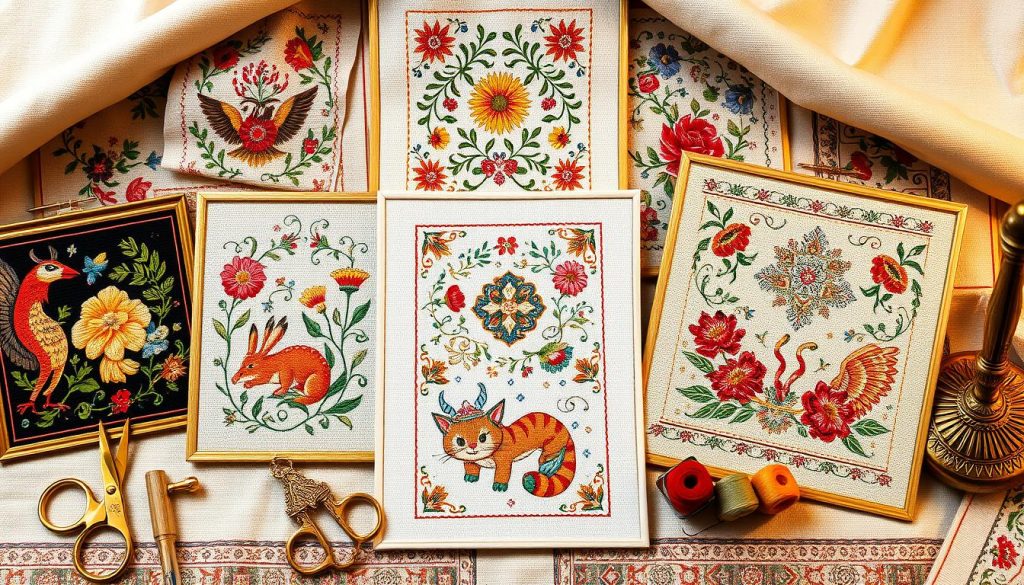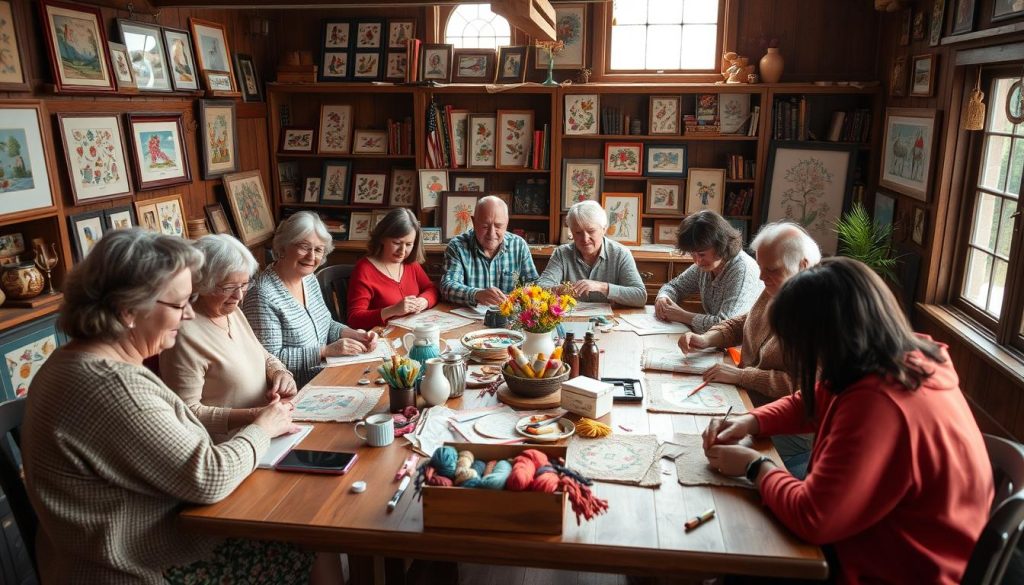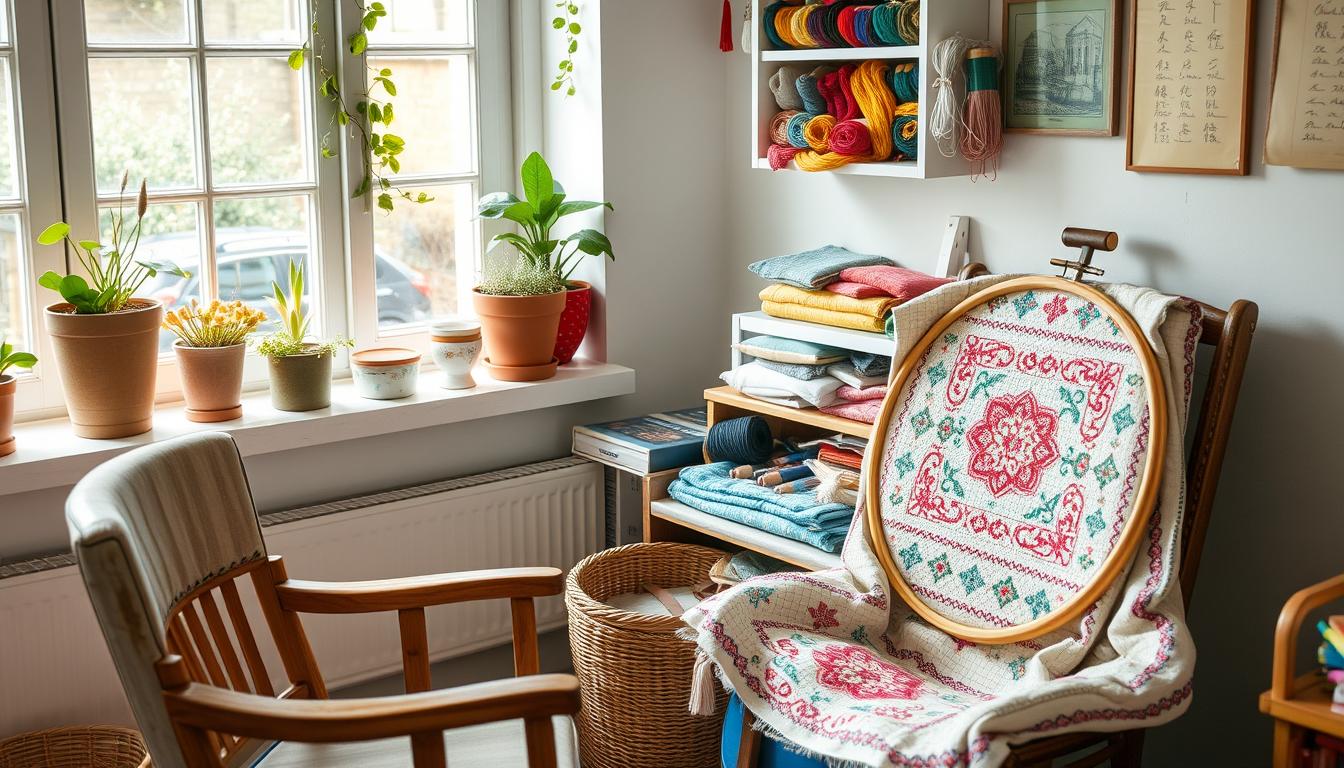Many think crossstitching is cheap, but it can cost a lot. You might spend a lot on threads and time on designs. This guide will help you see if your crossstitching hobby is worth it. We’ll look at what makes cross stitch supplies and activities expensive.
Figuring out how much crossstitching costs isn’t easy. On Etsy, some sellers charge too little for their work. It takes them at least 10 hours to complete. With the minimum wage, it’s hard to make a living from stitching unless you’re very skilled.
When setting prices, consider several things. This includes the cost of materials, your skill level, and how many stitches you use. Also, think about finishing methods and what people want to buy. Designs with special threads or glow-in-the-dark details cost more. Don’t forget to add in framing, finishing, shipping, and packaging costs.
Don’t sell your work for too little. It’s not just about money; it’s about the value of crossstitching as an art. Talk to your clients about the effort you put into each piece. This helps them see the real worth of your work.
Key Takeaways
- Cross stitch hobby expenses can exceed expectations due to premium materials and lengthy crafting times.
- Many sellers on platforms like Etsy may undercharge, insufficiently compensating their time and materials.
- Evaluate your crossstitching pricing with consideration for all costs, including framing and packaging.
- Avoid devaluing your work by pricing it too low; your skill and effort deserve fair compensation.
- Engage clients during the stitching process to help them appreciate the value and cost involved.
Understanding the True Cost of Cross Stitch Supplies
Starting a cross stitch project can be both rewarding and expensive. It’s important to buy supplies wisely to save money without losing quality or fun. Let’s explore ways to understand the real cost of your hobby.
Evaluating Cross Stitch Kits vs. Buying Supplies Separately
Cross stitch kits usually include everything you need. This includes threads, fabric, and needles. The price varies based on design size, material quality, and extras like hoops. For example, kits with high-quality materials like DMC threads can cost between £7.50 and £139.
Buying supplies separately can be cheaper. You might spend around $237 on materials alone. Here’s a quick comparison:
| Item | Cost |
|---|---|
| 148 DMC Colors | $1.50/color = $222 |
| 14 Count Aida Fabric | $15 |
Sourcing Discounted Cross Stitch Threads and Fabrics
It’s possible to find deals on threads and fabric. Online stores often have discounts of 30% to 40% off. Physical stores also have sales. You can also find second-hand supplies at lower prices on platforms like OfferUp and Facebook Marketplace.
Online stores usually have better deals because they have lower costs. Craft store loyalty programs can also help you save money after you spend a certain amount.
Choosing High-Quality, Cost-Effective Cross Stitch Needles
When picking needles, focus on quality rather than quantity. High-quality needles may cost more upfront but save money in the long run. They last longer and stitch better. Brands like John James and Bohin are known for their durability.
Choosing durable needles means you won’t need to replace them as often. This makes your cross stitch supplies more cost-effective.
The Financial Impact of Cross Stitch Patterns
Choosing crossstitching patterns can affect your wallet. Premium designs are pricey but offer top-notch quality. Free patterns are a budget-friendly option. DIY charts can be both a blessing and a challenge.
Investing in Premium Cross Stitch Designs
Premium designs cost more upfront but are worth it. They come with detailed guides, quality fabric, and threads. Brands like Coricamo use the best materials for a flawless finish.
Even though they’re pricey, these designs last long and look professional. They’re a solid investment for your stitching projects.

Exploring Free Cross Stitch Patterns and Resources
Free patterns are perfect for saving money. You can find them online without spending a dime. Sites like DMC have many free designs to try.
But, the quality of these free patterns can vary. You might need to buy your own materials to finish them.
Risks and Rewards of DIY Cross Stitch Charts
DIY charts let you customize and be creative. They can save money and make you feel proud. But, they take time and skill to make well.
Be ready for a learning curve. But, a well-made DIY chart can become a treasured keepsake or a special gift.
Cross Stitch Framing and Finishing Techniques
Learning about cost-effective framing and finishing for crossstitching can make your work last longer. It’s great for both new and experienced stitchers. Knowing how to display your work well can save money and make your craft better.
Cost-Effective Framing Solutions
About 63% of cross stitch fans choose DIY framing over professional services. These methods can save money without losing quality. You’ll need a frame, acid-free foam board, pins, craft paper, tape or glue, and hangers.
The pinning method is the most popular. It involves marking the center of the board and fabric with a pen. This keeps the fabric tight but not too tight. The lacing method is good for projects with little extra fabric. It uses thread and a needle to secure the fabric around the board edges.
DIY Finishing Techniques to Save Money
Framing your crossstitching doesn’t have to cost a lot. Using Anchor embroidery floss for lacing is preferred by 51% of crafters. Choosing affordable frames also helps. About 45% of hobbyists suggest leaving two inches of fabric around the edges for easier framing.
Online tutorials are valued by 82% of enthusiasts. They offer great tips on using affordable materials and finishing methods like pinning and lacing.
Tips for Using Cross Stitch Hoops and Stands
Using crossstitching hoops and stands is key to keeping your project’s tension and alignment right. Choosing the right hoop or stand can make your stitching more enjoyable and productive. These tools help complete your project and keep it ready for framing.
Cross stitch hoops come in different sizes and help control tension. Sturdy stands let you work hands-free, making details easier to manage. Together, they make stitching easier from start to finish.
Spending time learning about framing will be worth it. With DIY finishing and the right hoops and stands, your projects will look great and last forever. It’s a reward for your hard work and skill.
Community and Cross Stitch: A Key to Savings
Getting involved in cross stitch communities brings many benefits. It’s not just about sharing the love of stitching. It also helps you save money. By connecting with others, you find great resources and ideas for your projects.

Joining Cross Stitch Forums and Communities
Online cross stitch forums and communities are full of treasures. They’re perfect for swapping tips or finding the best supplies. Sites like The Cross Stitch Forum and Reddit’s r/CrossStitch are great places to connect. Members often share materials, patterns, and discounts.
Participating in Cross Stitch Stitch-Alongs (SALs)
Join stitch-alongs (SALs) to work with others on projects. SALs are led by designers and communities. They let you work on the same project as others. This way, you learn more and can share materials, saving money.
Leveraging Cross Stitch Blogs and YouTube Channels
For more ideas and tips, check out cross stitch blogs and cross stitch YouTube channels. Sites like Mary Corbet’s Needle ‘n Thread and Spruce Crafts have tutorials and free patterns. YouTube channels like “Stitching the Night Away” and “Cross Stitch with Luda” offer video guides. These resources help you avoid trial and error costs.
Balancing Passion and Expense in Your Cross Stitch Hobby
It’s key to keep your passion for crossstitching in check with your budget. While top-notch supplies can make your projects shine, watching your spending is vital. This balance ensures your hobby stays enjoyable for years to come.
Stitching offers many perks, like boosting creativity and focus, and calming your mind. Yet, it’s smart to think about spending wisely. Here are some tips to keep costs down:
- Budgeting: Create a monthly budget for your stitching needs. This way, you can enjoy your hobby without breaking the bank.
- Kit Selection: Opt for affordable cross stitch kits. They come with everything you need, saving you money compared to buying parts separately.
- Sourcing Discounts: Hunt for deals on threads and fabrics. Sales and coupons can cut your costs a lot.
- Community Engagement: Get involved in crossstitching forums or groups. They often share tips on finding cheap supplies.
Being active in your hobby can also greatly benefit your mental health. Cross stitch, like other hobbies, can lower stress, boost confidence, and improve mood. It’s a way to find balance and improve your life.
Trying out other crafts, like crocheting or needle felting, can also keep your passion for crossstitching alive. Switching things up can make your hobby exciting again, keeping it a source of joy.
Remember, the aim is to balance your love for cross stitch with the costs. By using these tips, you can enjoy your hobby without spending too much. This way, you get to enjoy the mental and physical benefits it offers.
Conclusion
Managing cross stitch costs is crucial for enjoying this hobby. Cross stitch kits can cost between $5 and $10. Fabrics range from $3.99 to $30, and floss is from $0.62 to $3 per skein. With smart budgeting, you can stitch without spending too much.
We’ve looked at the costs of supplies and patterns. We’ve also talked about saving money on framing and finishing. Joining a craft group can help you learn from others and improve your skills.
It’s important to balance your love for cross stitch with its cost. You can find deals on materials and use digital resources. This way, you can enjoy your hobby without breaking the bank. Whether you’re new or experienced, budgeting wisely will keep your hobby fun and affordable.
